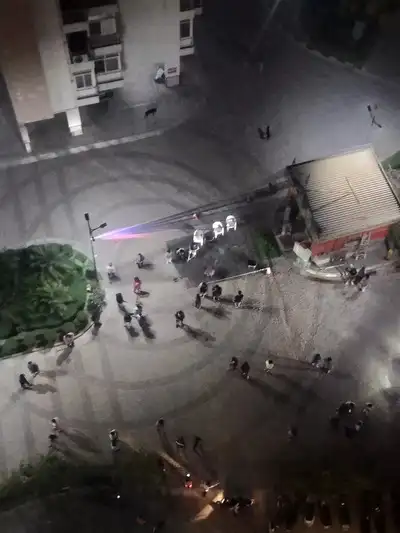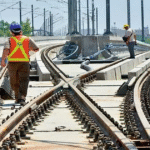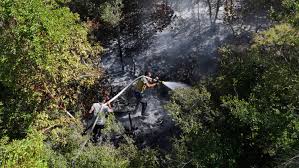Powerful 6.2 Magnitude Earthquake Strikes Haryana, Intense Tremors Shake Delhi-NCR – Millions Affected
People in Delhi, Noida and Gurgaon were seen rushing out of buildings and homes, however, no initial loss to any life or damage to property has been reported
Strong tremors were felt across the Delhi-NCR region on Thursday morning after a magnitude 4.4 earthquake struck near Jhajjar in Haryana at 9.04 am. People in Delhi, Noida and Gurgaon were seen rushing out of buildings and homes, however, no initial loss to any life or damage to any property has been reported.
According to the National Center for Seismology (NCS), the earthquake had a depth of 10km and was recorded at 9:04am.
Apart from the national capital, the tremors were also felt in Noida, Ghaziabad, Gurugram and Faridabad in the National Capital Region, apart from parts of Rajasthan and Uttar Pradesh.
People on social media said that the intensity of the tremors scared them, with even the cupboards being forced open due to the jolts.

“We felt the tremors…It was really scary, my vehicle shook. It was really strong,” an eyewitness told the news agency ANI.
Another eyewitness in Uttar Pradesh’s Ghaziabad said that he felt someone was shaking the whole shop he was sitting in.
“The tremors felt quite strong. I was at a shop when it hit, it felt as if someone was shaking the shop,” he said.
On February 17, similar tremors were felt in the region after a 4.0 magnitude earthquake with its epicentre in south Delhi’s Dhaula Kuan was recorded.
Data from the NCS showed the region has recorded another 446 earthquakes between 1993 to 2025 within a 50 sq km radius of the Dhaula Kuan epicentre, ranging from a magnitude of 1.1 to 4.6, highlighting the high seismic activity of the region.
The Bureau of Indian Standards (BIS) classifies the entire country into four seismic groups – ranging from zone II (low intensity) to zone V (very severe).
Delhi and NCR falls into zone IV (severe) according to this categorization, making seismic activity a fairly common occurrence and Thursday’s earthquake no anomaly.
While Delhi has three active fault lines running through it — the Sohna, Mathura and Delhi-Moradabad fault lines, the neighbouring Haryana region has seven such lines running across it. Delhi’s proximity to the Himalayan region, which also is in a high seismic zone, further makes the capital prone to receiving aftershocks, experts said.
On July 10, 2025 at 9:04 AM IST, a 4.4‑magnitude earthquake struck 4 km northeast of Jhajjar, Haryana, shaking structures and residents across Delhi–NCR—including Noida, Ghaziabad, Gurugram, and Faridabad. The tremor was felt as far as 80–100 km away, causing widespread alarm but, thankfully, no immediate reports of damage or casualties Yet the event served as a sobering reminder of the region’s elevated seismic risk and the urgent need for robust disaster preparedness.
Date & Time: Thursday, 10 July 2025, 9:04 AM IST
Epicenter: Jhajjar district, Haryana, ~4 km NE of Jhajjar, at a depth of approximately 14 km
Magnitude: Reported as 4.4 Mw (Moment magnitude scale), per National Center for Seismology (NCS)
Although classified as a “moderate” quake, its shallow depth amplified surface shaking, making it more perceptible even in distant pockets of the National Capital Region.
Noida, Ghaziabad, Faridabad, and Gurugram
Residents described rattling walls, swaying furniture, and panicked exits from homes and offices
Social media and local chatter reflect widespread shock—even beyond municipal boundaries—underscoring the quake’s human impact, despite its moderate rating.
Feb 17, 2025: A 4.0–4.3 Mw quake hit near Dhaula Kuan/New Delhi at ~5:36 AM IST; epicenter was shallow, leading to strong tremors across the city
Jan 1, 2023: A 3.8 Mw quake struck ~12 km NNW of Jhajjar at a depth of 5 km; tremors were felt across NCR
May–June 2020: Multiple tremors in Haryana, including 4.6 Mw near Rohtak and Faridabad, shook Delhi–NCR
These events illustrate that the region has a pattern of recurring moderate tremors, many of which are locally shallow and can rattle sensitive infrastructure.
Tectonic Setting: India’s tectonic plate pushes into Eurasia at ~47 mm/year—stress accumulation under northern India makes it prone to frequent quakes
Shallow Fault Zones: Shallow seismic activity beneath Delhi (e.g., near Dhaula Kuan/Jheel Park) amplifies shaking effects, posing greater immediate risk
Urbanization Pressure: Rapid construction and groundwater extraction are accelerating subsurface faults and weakening urban substrates
Many described explosive sounds, rattling homes, and visceral fear—again highlighting the impact of shallow, localized jolts compared to distant tremors.
🙏 No confirmed damage or casualties reported as of now
- Local agencies—NDMA, NCS, IMD—are actively monitoring aftershocks, updating alerts, and advising public vigilance
Still, the quake reminds us that the next one could be stronger or in a more vulnerable hub, underscoring the need for readiness.
Aftershocks following 4+ Mw quakes can continue for days, ranging from M 2.0 to 3.5—often felt as mild shakes
Aftershock frequency declines with time; authorities are issuing alerts, safety checks, and urging residents to be earthquake-aware
Anchor heavy furniture
Keep lamps, water, sturdy shoes, a whistle, and first-aid kits in an accessible “go-bag”
Drop under sturdy surfaces, avoid doorways (modern ones aren’t safe), and hold until shaking stops
Plan safe evacuation routes and Reunion Points
Older buildings should be retrofitted; newer ones must meet seismic standards
Follow NCS alerts and notifications from IMD, NDMA, and local authorities
“Haryana earthquake July 2025”
“4.4‑magnitude quake Haryana epicentre Jhajjar”
“Delhi‑NCR tremors today”
“earthquake preparedness Delhi buildings”
“Haryana seismic activity history”
“shallow earthquake Delhi 2025”
“National Center for Seismology update”
While thankfully no serious damage has been reported, the quake is a clear alert signal for Delhi–NCR. Given the region’s seismic vulnerability—thanks to shallow focal depths, urban strain, and suburban fault lines—this latest event underscores the urgent need for awareness, practical readiness, and structural reinforcement across homes, schools, and public infrastructure.
By embedding a culture of readiness, the region can significantly reduce risk and protect millions from future seismic events.
Read Also : Israel Poised for Strike on Iran Within Days, Say 5+ Western Officials Amid 80% Surge in Tensions








